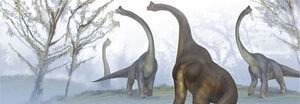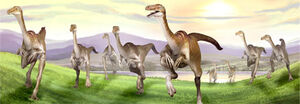Tour the Island is an interactive map made by Telltale Games for Jurassic Park: The Game. It features a map of the game's version of Isla Nublar and you can click on pictures to learn about the specific location.
Map[]
Park Locations[]
Visitor Center[]

Visitor Center
Visitor Center
At the heart of Jurassic Park, our multi-level visitor center is where you’ll begin your prehistoric adventure. The central rotunda displays the fossilized remains of creatures we have brought back from extinction through the science of genetic engineering. They are a reminder of a past where we could only look at the bones of the now living, breathing creatures of Jurassic Park. State of the art technology delivers an experience like no other as you visit the actual labs and hatchery where the animals of the park are created and born! The visitor center also offers fine dining at our restaurant Les Gigantes and don’t forget to visit the gift shop!
Tour Vehicle[]

Tour Vehicle
Tour Vehicle
Cutting-edge technology provides a one of a kind private safari tour experience of Jurassic Park. No expense has been spared on our custom fleet of green and sustainable electric SUVs, outfitted bumper to bumper with the latest in technology. Sit back and relax while listening to our interactive CD-ROM tour program. Never mind the steering wheel, our completely automated fleet will handle the drive for you!
Red icons (Predators)[]
Velociraptor Exhibit[]

Raptor
This 11 foot long dinosaur lived during the early Cretaceous Period, about 115–108 million years ago. An incredibly intelligent and fleet of foot pack hunter, credited with initiating the ‘dinosaur renaissance’ during the 1960s where the image of dinosaurs as slow, clumsy, reptilian giants was superseded by an image of warm-blooded, fast moving animals. In addition to problem-solving intelligence, one of Velociraptor’s defining features is an oversized, sickle-shaped talon on each foot. These talons are used during hunting and combat to inflict deep and fatal wounds.
Herrerasaur Paddock[]

Herrerasaurus
Herrerasaurus
Herrerasaurus was one of the first Theropods dinosaurs and lived during the mid-Triassic period, a time when dinosaurs were not yet the dominant land animals on Earth. Sharing many of the same physical features of later theropods such as Allosaurus, this hunter - which can reach up to 20 feet in length - will swallow down huge chunks of prey whole, in fact, it can digest bone, something other carnivores usually leave behind! A fast mover with beautiful markings, Herrerasaurus is a wonderful addition to the creatures of Jurassic Park.
Dilophosaur Paddock[]

Dilophosaurus
Dilophosaurus
Dilophosaurus, (early Jurassic period, about 193 million years ago) is a recent addition to the park and is our most surprising specimen to date. Still juvenile, our “Dilos” measure in at 6 feet in length, with an adult expectancy of nearly 20 feet! Though they hunt in packs, they rely on a pack leader to incapacitate prey by expelling venom from glands in its mouth. Dilophosaurs can ‘spit’ their venom up to 20 feet with deadly accuracy, aiming for their prey’s eyes causing blindness and disorientation.
Tyrannosaur Paddock[]

Tyrannosaurus
Tyrannosaurus rex
Tyrannosaurus rex is perhaps the best known dinosaur in the world…and for good reason! Standing over 13 feet tall at the hips, 40 feet from snout to the tip of its tail and weighing around 7 tons, T rex was one of the largest carnivores ever to walk the Earth. Its original home was North America during the late Cretaceous period (67 – 65 million years ago) where it would stalk Triceratops among other prey. Tyrannosaurus has excellent binocular vision and hence good depth perception – an adaptation essential to a predator. Despite this, observations have shown that T-Rex’s vision is primarily attuned to motion, supplemented by a remarkable sense of smell. Our living specimens have proven once and for all that T rex was no slouch, reaching speeds of over 30 miles per hour!
Compsognathus Paddock[]

Compsognathus
Compsognathus
Compsognathus, often referred to simply as "Compy", is a chicken-sized dinosaur from the late Jurassic period (around 150 million years ago). It was first discovered in Germany before the only other specimen to be found was unearthed in France. Compys typically hunt small lizards and insects, but like other opportunistic theropods, will scavenge larger animal carcasses when available.
Green Icons (Herbivores)[]
Parasaurolophus Paddock[]

Parasaurolophus
Parasaurolophus
Parasaurolophus is a Hadrosaurid (sometimes called a duck-billed dinosaur) from approximately 76.5–73 million years ago (late Cretaceous). It is a herd animal feeding on the park’s rich vegetation. The most stunning feature of the Parasaurolophus is the crest on its head. Scientists were unsure of its function until today. Some believed it was a snorkel for when the animal was in water; others felt that it was used in combat. We now know that it serves for display and for communication, allowing the animals to remain in contact over distance by amplifying their haunting, beautiful cries.
Brachiosaur Enclosure[]

Brachiosaurus
Brachiosaurus is a large sauropod dinosaur that originally lived during the late Jurassic period (150 to 140 million years ago) in what is now Africa and North America. Our Brachiosaurus represent an average size specimen of the largest land animals to have ever lived. They are herd animals that move in family groups much like modern elephants.
Triceratops Paddock[]

Triceratops
Triceratops
Triceratops is a large ceratopsian (horned and frilled herbivorous dinosaur) that lived in the late Cretaceous period 68-65 million years ago in North America. It filled a similar ecological niche to today’s buffalo, roaming the grasslands in massive herds. Although an herbivore, it is one of the park’s most dangerous animals. Reaching nearly 30 ft in length and weighing up to 12 tons, its size alone makes for a formidable creature. Sporting a fiery temper and horns of over 3 feet in length, this is an animal deserving serious respect.
Galimimus Enclosure[]

Gallimimus
Gallimimus originally lived during the Late Cretaceous period (75-65 million years ago). Similar to today’s gazelle and antelope, Gallimimus moves in herds ranging across the park’s grassland areas. They will often move around on all four limbs when feeding, but find it just as easy to stand on two legs. In fact, they are excellent runners, reaching speeds in excess of 40 miles per hour.
Blue Transport Icons[]
North Dock[]

North Dock
If you arrive by sea, our main dock facility will be your first experience of Jurassic Park. As you disembark from your luxury cruise liner, you will be met by our friendly and knowledgeable tour guides who will take you aboard VIP transportation to our visitor center where your Jurassic adventure will begin! Consult your travel agent for affiliate ports and cruise lines.
East Dock[]

East Dock
Our east dock is where we receive all of the supplies that can’t be produced on the island and where our staff members travel from when they need to return to the mainland.
Isla Nublar Heliport[]


Located at the foot of a mighty 360 foot high waterfall, our heliport offers the fastest way to visit Jurassic Park. Arrive in style from nearby Costa Rica and take advantage of our “Pterosaur’s Eye View” tour of the park’s spectacular coastline. Consult your travel agent for details.
InGen Icons[]
Five InGen icons are located in the northern part of the island. In the movie version of the map, these parts were (mostly) empty. When you click on the icon, a password is asked.
When you type in please the locations are revealed.
Quarantine Pens[]

Quarantine
Despite protests from Dr. Sorkin, the board has unanimously agreed that species (IG74726f6f646f6e) should be stricken from the park population. All embryos and genome data will be shelved and the current stock euthanized. Behavioral and physiological traits of the lot plus its inherent nocturnality make it a dangerous species to handle with very little tourism appeal.
Isla Nublar Field Lab[]

Field Lab
Dr. Sorkin’s relocation to the field lab has allowed Dr. Wu to meet the goals required for the park to launch on schedule. However, her invaluable insights mean that her continued employment is necessary. Concerns have been expressed over her work on animals that are not financially viable, either through poor exhibit qualities or where they present an unacceptable danger to park visitors and staff. In many ways, she appears to be more concerned about the animals of the park than financially-driven goals mandated by InGen corporate. Recommend reassignment to Site B population research and development.
Geothermal Power Plant[]

Geothermal
Per schedule, the geothermal plant is operating at 30% capacity until phase II projects come on line. At current figures, the plant will provide approximately twice the energy requirements of the final park systems running at only 80% capacity. Due to the complexity of emergency shut down and start up procedures, we recommend that access to power systems be restricted to trained personnel only. Also, new safety installations are finally up to code, but Hammond insists that plant areas be regularly inspected for new magma vents. The geologist’s invitation to the park has been revoked per Mr. Gennaro’s insistence.
Bone Shaker[]

Boneshaker
The Boneshaker rollercoaster is 90% complete at the time of writing. We are told that with sufficient testing that it and the other rides will be ready in advance of Phase II. A soft launch during Phase I is recommended given financial pressure from our investors. Muldoon and others have expressed concern over the amusement park’s proximity to the Hererrasaurus and Raptor enclosures; however, there are no grounds for concern given the security measures in place.
Marine Facility[]

Marine Facility
Currently scheduled to be opened to visitors 6 months after the main park, the marine facility will offer more revenue generation opportunities. Phase II PR and marketing campaigns are ready for approval. The Mosasaur will provide the star attraction as Jurassic Park’s ‘Devil from the deep’. Newly hired marine animal behaviorists and redesigned safety protocols will assure a thrilling and family friendly marine spectacular.
Trivia[]
- The only locations that lack videos are the Brachiosaurus, Gallimimus, the Heliport, and the Watering Hole.
- This is because they never appear in-game, so Telltale didn't have any footage to work with.
- Interestingly, the watering hole is labeled, but doesn't have its own article for unknown reasons.

